FW
Saurer will present its new air-spinning machine Autoairo at CIIE that will be held from November 05-10, 2019.
The Autoairo features autonomous spinning positions with individual drives and integrated intelligence. Its digital piecing unit is capable of performing up to 24 piecing processes simultaneously. As a result, the machine’s run-up time is also reduced by at least 30 per cent. The Autoairo’s compact, double-sided design means that it takes up 40 per cent less space than single-sided machines. These features give the Autoairo a powerful productivity advantage, while at the same time lowering spinning costs.
This innovation significantly increases efficiency. It is fully automated with autonomous, intelligent spinning positions, revolutionising air spinning. With Autoairo, spinning mills can produce high-quality yarn more quickly, more cost-efficiently and more flexibly.
With more than 160 years’ experience, Saurer has always been committed to advancing the textile industry, integrating high-end equipment manufacturing with modern information technology to provide complete solutions for the smart spinning factory.
Prada’s fall/winter line Linea Rossa has a strong military theme.
There are lots of khaki and battleship grey officer’s raingear, parkas and hooded trenches – all finished with the signature white on red logo strip. Active sports gear has bright primary color ski pants and ski-boarder jackets. Tough chic black is a running theme in the mini hooded bolero puffers in black nylon worn over graphic anthracite leggings and chunky mountaineers sneakers. The look is protective but with plenty of panache. Everything is made in forward-thinking fabrics – from the graphene and recycled polyester padding, conductive and reactive fabrics like Tela Tecnica Pro and seamless knits that are pH-balanced for a hyperallergic effect – reducing moisture and minimizing odors.
After a hiatus of over a decade, Prada relaunched Linea Rossa last year, upgrading the collection’s scientific element and positioning its price point further up the chain.
Streamlined engineering is the new buzzword at Prada. In a novel move, Prada rolled out its latest ideas internationally with a series of presentations in boutiques and outside events in several countries. It was all about savoir-faire meeting urban and active sportswear. In Paris, Prada showed around 40 looks on mannequins inside its flagship, while in London it collaborated with Willow Smith, who staged an impromptu live performance.
Jeanologia is collaborating with international universities and bodies to develop a more efficient, sustainable and transparent textile industry by supporting a new training model that addresses the needs of digitalisation and transformation in the textile industry.
The training includes master classes, talks, sustainable finishing training, collaborations with capsule collections, talent rewarding, teaching on digital transformation strategies, on sustainable design and on circular economy, at some of its centers across the world.
The schools with which Jeanologia is collaborating includes the Parsons Art and Design School, the Fashion Institute of Technology in New York, Ravensbourne University in London, Fashion Design School in Singapore, National Textile University in Pakistan, I-Skool Denim and Jeans School in Amsterdam .
Jeanologia started up The School in 2013. This training grant provides designers with an opportunity to acquire all of the skills and knowledge necessary in design for textile laser, textile production techniques, sustainable design and denim product development.
The company provides a complete range of services to its clients since the selected students have four months of advanced training and after that, they have the possibility to be hired by these clients and work at their production centres around the five continents.
Increase in health awareness is shifting the focus of Indian consumers toward sportswear.
The Indian sports apparel market is segmented based on end user and mode of sale. By end user, the market is categorised into men, women, and children. On the basis of mode of sale, it is segregated into retail stores, super markets, brand outlets, discount stores, and online stores.
Sports apparel includes tracksuits, gym suits, yoga wear, swim wear, and tights. Such clothing has advantages like prolonged durability, improved range of motion, breathability of material, and superior comfort. They avert ligament injuries and physical strain on muscles and enhance performance. Endorsements of sportswear by celebrities influence the growth of the market. Additionally, Indian icons who consider themselves as fitness conscious promote apparel brands, which acts as a major driving factor of the sportswear segment, thereby contributing in expanding the customer base. The Indian sportswear industry is benefiting from the increasingly organized modern retail, consisting of a planned approach to distribution and logistics management, targeting urban as well as smaller developing towns. This is viewed as an opportunity by sportswear manufacturers. However, the counterfeit trade in sportswear is restraining the growth of the market.
Major players in the Indian sports apparel market include Adidas, Nike, Puma and Fila.
The Ministry of Industry of Mynamar plans to set up special zones for textiles and garments in the Yangon and Mandalay regions. The ministry will collaborate with the private sector to implement these pilot projects for industry complexes and clusters.
The Ministry also plans to launch a national level textile policy with the help of German global development organisation GIZ to develop the country’s textile industry, boost investment by inviting foreign trade partners, set up the necessary infrastructure and reduce imports.
The proposed national textile policy is part of the National Export Strategy (NES) which the commerce ministry is implementing with 11 sectors.
Gildan Yarns, based in the US, is investing in a new yarn spinning facility.
This will be the company’s seventh yarn spinning facility in the US. Gildan Yarns is the yarn spinning division of Gildan, a leading apparel manufacturer headquartered in Canada.
Gildan makes most of its garments offshore, with close to 90 per cent of its 42,000 employees in low-cost Caribbean and Central American countries. It has yarn spinning and distribution centers in cheaper parts of the United States, including North Carolina and Georgia. This new location will be the company’s fifth state-of-the-art yarn spinning mill in North Carolina. Eden is also home to Gildan’s first large scale distribution center. North Carolina has more textile manufacturers than any other state and a world-class pipeline of textile talent to continue Gildan’s global operations.
Gildan has partnered with Sans Soucie. The partnership is part of Gildan’s mission to save fabric waste from landfills—89 per cent of which is already upcycled into other products. Gildan’s new partnership follows its recent environmental commitments. Vancouver-based Sans Soucie Textile and Design is a zero-waste clothing and textile design studio that transforms off cuts from nylon for hosiery into new handmade materials for garment production.
Sportswear giant Adidas has launched a new sustainable initiative that rewards customers with coupons in exchange for their old clothes.
The sportswear company has launched this initiative for members of its loyalty club in the United Kingdom. The proposal encourages customers to deliver their used clothing in exchange for a coupon. The company implements this initiative in collaboration with the Stuffstr startup, which, once the customers’ clothes have been collected, is in charge of repairing it, selling it again or reusing it for the production of new clothes. It has already launched a sustainable collection this year in collaboration with Stella McCartney, called Futurecraft.loop.
The clothing return method is applied to those garments with a value starting from 20 pounds or higher through the Creator’s Club app, which will reward customers with coupons. Stuffstr will be dedicated to offering a free collection service for those products that want to be returned and will manage their resale possibilities.
Adidas launched a similar concept in Brazil, in 2012, and in Canada, in 2016, and plans to expand the initiative to other countries next year. Along the same lines, Burberry and The RealReal, the luxury goods shipping market, have recently announced similar bets for circular economy.
"The recently concluded Autumn Edition of Intertextile Shanghai Apparel Fabrics marked the 25th year of the launch of this trading platform. With 89,662 visitors from over 120 countries and regions, the exhibition proved to be an ideal platform for them to meet global partners. “Exhibitors use this platform to unveil their latest collections,” said Wendy Wen, Senior General Manager, Messe Frankfurt |(HK). "This in turn attracts more visitors from all over the world. At this edition, we welcomed trade buyers from more countries and regions. The fair’s diverse network of suppliers and buyers ensured definite business for its visitors,” Wen added."
 The recently concluded Autumn Edition of Intertextile Shanghai Apparel Fabrics marked the 25th year of the launch of this trading platform. With 89,662 visitors from over 120 countries and regions, the exhibition proved to be an ideal platform for them to meet global partners. “Exhibitors use this platform to unveil their latest collections,” said Wendy Wen, Senior General Manager, Messe Frankfurt |(HK). "This in turn attracts more visitors from all over the world. At this edition, we welcomed trade buyers from more countries and regions. The fair’s diverse network of suppliers and buyers ensured definite business for its visitors,” Wen added.
The recently concluded Autumn Edition of Intertextile Shanghai Apparel Fabrics marked the 25th year of the launch of this trading platform. With 89,662 visitors from over 120 countries and regions, the exhibition proved to be an ideal platform for them to meet global partners. “Exhibitors use this platform to unveil their latest collections,” said Wendy Wen, Senior General Manager, Messe Frankfurt |(HK). "This in turn attracts more visitors from all over the world. At this edition, we welcomed trade buyers from more countries and regions. The fair’s diverse network of suppliers and buyers ensured definite business for its visitors,” Wen added.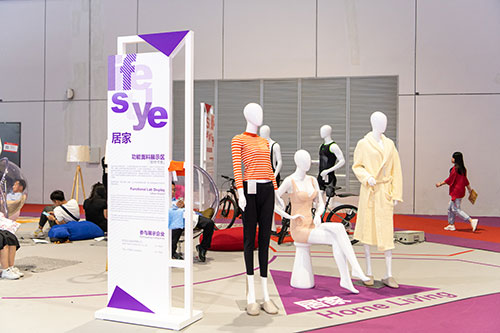
The fair was held concurrently with Yarn Expo Autumn, CHIC and PH Value from 25 – 27 September, at the National Exhibition and Convention Center (Shanghai). It was co-organised by Messe Frankfurt (HK) Ltd; the Sub-Council of Textile Industry, CCPIT; and the China Textile Information Centre.
A one-stop shop for apparel products
Over 4,422 exhibitors from 33 countries and regions exhibited at 2019 edition of Intertextile Shanghai Apparel Fabrics. These also included buyers participating for the last 10 to 20 years. The fair’s product zones, such as Functional Lab and Beyond Denim, offered an easier way to its exhibitors to meet their target buyers.
Roundtable meeting with industry leaders of different countries
For the first time during the inaugural day at Intertextile Shanghai, a roundtable meeting consisted of association and trade body heads from various countries. Zhao Hong, China Textile magazine, who moderated the roundtable conference, explained “The theme of this roundtable meeting is sharing and getting insights on the future of apparel and textile industry, sustainability and opening to the possibilities of international cooperation.”
It is interesting to note here that this comes at a time when China is grappling with an ongoing trade war situation with the US. China seems to be opening up and looking for more cooperation in the region to keep its position strong and working out with more and more countries through its existing initiatives like One Belt One Road (OBOR).
While making a detailed presentation about China’s textile and apparel industry, its technology, R&D and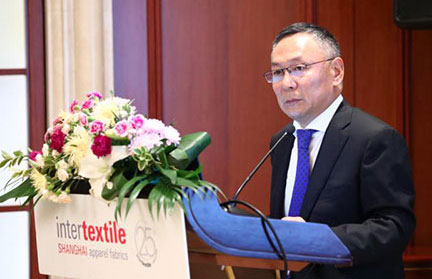 designing drive , Xu Yingxin, VP, CNTAC and President, The Sub-Council of Textile Industry CCPIT, expressed deep concern about the China-US escalating trade conflict over last one year. The USA is China’s biggest importer with a 38 per cent share through wide ranging products.
designing drive , Xu Yingxin, VP, CNTAC and President, The Sub-Council of Textile Industry CCPIT, expressed deep concern about the China-US escalating trade conflict over last one year. The USA is China’s biggest importer with a 38 per cent share through wide ranging products.
After 12 rounds of negotiations already concluded between the world’s two largest economies, the friction is likely to impact exports of China if the conflict continues. Small and medium enterprises are more vulnerable, resulting in unemployment and dwindling investments in the textile industry.
Summarizing the situation, he said, “We are seeing an era of uncertainty where we will have to face a Sino-US trade war and we have to be very patient and resistant, but we are simultaneously opening to all markets and we believe in cross country development. “
Though a few of the association heads representing their respective countries were upfront in admitting that the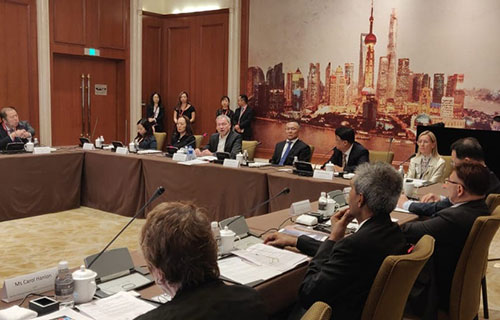 trade war between the two countries is helping them to grow in exports to the US, at the same time, it was widely agreed that the conflict is not good as it is bringing in a lot of uncertainties in global trade and should soon be resolved. Also OBOR is a great initiative and will help all the countries who are participating in it with logistic solutions, lowering prices. It will bring in a lot of growth in global trade.
trade war between the two countries is helping them to grow in exports to the US, at the same time, it was widely agreed that the conflict is not good as it is bringing in a lot of uncertainties in global trade and should soon be resolved. Also OBOR is a great initiative and will help all the countries who are participating in it with logistic solutions, lowering prices. It will bring in a lot of growth in global trade.
Country pavilions forecast future trends
The fair also organised country pavilions for visitors interested in more Asia-Pacific trend forecasts. The Japan pavilion featured many Japanese companies which brought the global industry together. One such exhibitor included Asahi Kasei Corporation which was represented by Kiichiro Kobayashi the Manager of its Fibres & Textiles Marketing Dept. Kobayashi views the fair as “the best platform to access the Chinese market as it offers its buyers an opportunity to partner with some of these visitors later.”
The Korea Pavilion achieved remarkable business results just from the first two days of the fair, thanks to their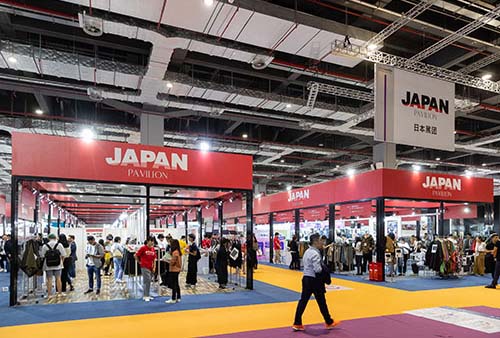 high quality products. “This fair provided us with an opportunity to introduce Korean textiles to an international market effectively,” said Young Sang Yoon, Vice President of Korea Fashion Textile Association, Korea.
high quality products. “This fair provided us with an opportunity to introduce Korean textiles to an international market effectively,” said Young Sang Yoon, Vice President of Korea Fashion Textile Association, Korea.
Leading European and US trading companies at the sustainability zone: The All about Sustainability Zone featured Testex AG, an independent Swiss testing and certification organisation which was the official representative for OEKO-TEX. Led by its group CMO, Marc Sidller, the company has been hosting a pavilion for the last five years. “This year, we had the opportunity to interact with some of the best European and US trading companies and brands,” Sidler reveals
SalonEurope: The SalonEurope zone also recorded a good visitor turnout. Paul Alger, International Business Director, UK Fashion & Textile Association noted, “We were extremely happy with the visitor turnout.”
Premium Wool Zone: The Premium Wool Zone was attended by companies like Dormeuil who have  been exhibiting in this zone for the last 10 years. “China is a very important for us and we want it to become our top market in the next few years,” noted Aline Galimberti, the Product Manager of the France-based company.
been exhibiting in this zone for the last 10 years. “China is a very important for us and we want it to become our top market in the next few years,” noted Aline Galimberti, the Product Manager of the France-based company.
Verve for Design: The Verve for Design zone was a great hit with visitors thronging the stall on the first day itself. Joe Moreline, Sales, Camilla Frances revealed, “We had buyers mostly from China and Australia. We were surprised to see some of our existing Australian customers too.”
The fringe programme included Asia’s first ever Fashionsustain conference; a round-table meeting focused on international trade and sustainability; the Intertextile Consumer & Lifestyle Trend, themed FutureCast 2021: New Consumer Rules; the Smart Factory Forum, a panel discussion focused on Artificial Intelligence (AI) applications and trends; and an industry crossover with Messe Frankfurt’s new fair Licensing China which included a licensing seminar and display area.
The key to business in China is a face-to-face interaction with the textile industry. Intertextile Shanghai’s 25 years of experience have made this a trusted platform, for both exhibitors and trade buyers in China, to trade textiles.
"With a record-breaking 543 exhibitors from 14 countries and regions, Yarn Expo Autumn 2019 offered an unparalleled range of quality and product diversity. Held from September 25-27, 2019 at the National Exhibition and Convention Centre in Shanghai, the expo showcased an array of fancy, specialty and regenerated yarns, as well as high quality cotton, wool, silk and linen. Its new display zone, Fancy Yarn Vision, proved to be popular stop for buyers to quickly and efficiently see samples from highlighted fancy yarn exhibitors on offer."
 With a record-breaking 543 exhibitors from 14 countries and regions, Yarn Expo Autumn 2019 offered an unparalleled range of quality and product diversity. Held from September 25-27, 2019 at the National Exhibition and Convention Centre in Shanghai, the expo showcased an array of fancy, specialty and regenerated yarns, as well as high quality cotton, wool, silk and linen. Its new display zone, Fancy Yarn Vision, proved to be popular stop for buyers to quickly and efficiently see samples from highlighted fancy yarn exhibitors on offer. Sustainability remained a key trend at event with fringe events by the European and Chinese exhibitors focusing on sustainable products.
With a record-breaking 543 exhibitors from 14 countries and regions, Yarn Expo Autumn 2019 offered an unparalleled range of quality and product diversity. Held from September 25-27, 2019 at the National Exhibition and Convention Centre in Shanghai, the expo showcased an array of fancy, specialty and regenerated yarns, as well as high quality cotton, wool, silk and linen. Its new display zone, Fancy Yarn Vision, proved to be popular stop for buyers to quickly and efficiently see samples from highlighted fancy yarn exhibitors on offer. Sustainability remained a key trend at event with fringe events by the European and Chinese exhibitors focusing on sustainable products.
Exhibitors note an optimistic future outlook
Despite economic uncertainty within the Chinese market, many exhibitors at the event noted optimistic outlook for their future. This optimism was mainly credited to the resilience of China’s dominant purchasing power. The fair also received a good feedback from its Southeast Asian exhibitors, one of whom included Ravindranathan Narayanasamy, Director of the Cotton Textiles Export Promotion Council, India. Elaborating on this expo, Naryanasamy, “Yarn Expo is growing larger and becoming more international each year. This year, our exhibitors met visitors from Korea, Egypt and Europe. We also received 40 onsite orders at the India Pavilion.
for their future. This optimism was mainly credited to the resilience of China’s dominant purchasing power. The fair also received a good feedback from its Southeast Asian exhibitors, one of whom included Ravindranathan Narayanasamy, Director of the Cotton Textiles Export Promotion Council, India. Elaborating on this expo, Naryanasamy, “Yarn Expo is growing larger and becoming more international each year. This year, our exhibitors met visitors from Korea, Egypt and Europe. We also received 40 onsite orders at the India Pavilion.
Similarly, the Cotton Council International of USA recorded over 140 visitors at its booth. “We met visitors from Indonesia, Thailand and other Asian countries,” said Shoapiing Li, Senior Manager, China Supply Chain Marketing of the Yarn and Home Textiles Department of the company. “These visitors spanned different industry roles. Some of these have already started contacting our sales team to place orders.”
An effective getaway for brand promotion
The fair resulted in several new business deals being signed amongst its visitors and exhibitors. A prime example of this was the Uztex Group, which signed over three deals at the fair.” These deals will take our company to the next level in the Chinese market,” said Ravshan Kambarov, Commercial Director of the company. “We had orders not only from China but also Turkey and Iran. There are lots of different markets here, mostly from India, Bangladesh, Pakistan and China,” he added.”
The fair also proved to be an effective gateway for Korean companies like HJLite for promoting its products and brand image. “The buyers in this fair are diverse which helps us to explore the Chinese and European markets. People can explore numerous products in one place in a short time,” said Joon Son, Sales Manager, HJLite, Korea. r Steven Shen, Textured Yarn Dept. Director, Everest Textile, Taiwan
A must-attend for visitors
Yarn Expo is ‘must attend’ event for its visitors as it has a significant influence on their company’s business strategy. “The new Fancy Yarn display area at the expo is very handy to find good quality fancy yarn exhibitors and I can find whatever I want here,” says Bonnie Chan, Manager of Raw Materials, Pacific Textiles, one of the visitors at the show. The expo also serves as a platform for networking and partnership exploration. “I sought out 30 potential suppliers that I am interested in, and I look forward to establishing business with them,” said Marcin Kolasa, Product Development, Legs Sp. z o.o, Poland. Going beyond a sourcing channel, this show acts like a stage for displaying high-quality products and innovative concepts,” Rajiv Srivastava, Manager, Neman Brothers & Assoc., USA, summed up.
"A meeting point of all global players in the lingerie and swimwear industry, Interfiliere Shanghai offered a China-based view of textiles and textile accessories for lingerie and swimwear industry. Organised from September 26-27, 2019 in the Chinese capital city, the event reflected the current fashion trends in China. It featured one of the most comprehensive displays of the best in apparel, textiles, and machinery pertaining to this sector."
A meeting point of all global players in the lingerie and swimwear industry, Interfiliere Shanghai offered a China-based view of textiles and textile accessories for lingerie and swimwear industry. Organised from September 26-27, 2019 in the Chinese capital city, the event reflected the current fashion trends in China. It featured one of the most comprehensive displays of the best in apparel, textiles, and machinery pertaining to this sector.
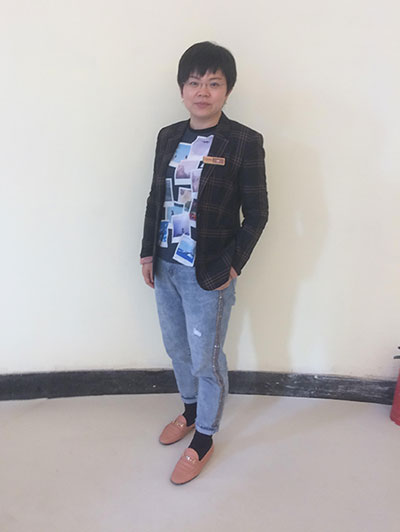
One of the main focus areas of the exhibition included technological developments in the lingerie industry. Xianming- a luxury brand operating for the last 20 years mapped these developments over the years. Its spokesperson noted, “3D printing technology reinvents the traditional way of making a bra. It enables us to create a seamless bra. People with health issues can wear this lingerie or active wear.”
Colors and fabrics trends
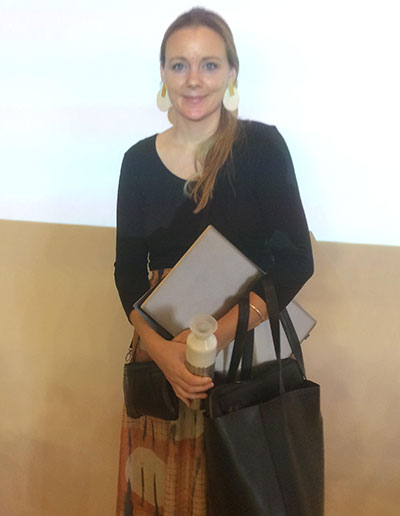
Vanessa Causse, a fashion forecaster predicted the lingerie fashion and social micro trends for the upcoming Spring/Summer 2020 season. “This season will focus on the brown and white colors. This black will be different from the usual black color. Fabrics will be made from new fibers like bamboo or bean or a mix of polyamide with spuntech,” she said further adding that “the global slowdown is certainly affecting the lingerie industry. To tackle this, we need to improve our efforts on sustainability.”
Addressing sustainability with new materials and fibers
The importance of sustainability in the Chinese fashion industry was emphasised upon by Martin Lehpur, a fashion consultant for trends and strategies for brands.”China gives importance to green. It is an eco-conscious country and poised to be the first green country in the world. Also, the lingerie brands in China are quick to adapt to changing trends as they do not have any baggage of the past,” Lehpur said.
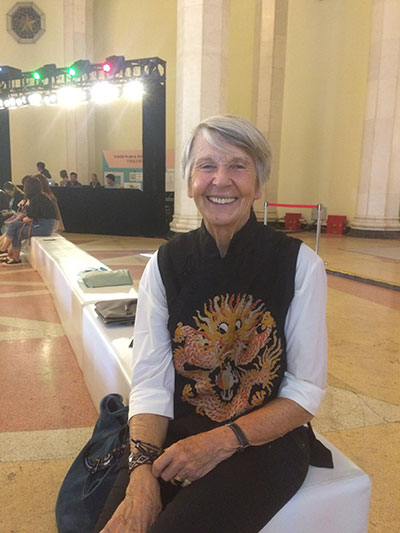
Marina Chaboune, a sustainability manager based in Indonesia, looked a ways to create new materials and fibers. “There are materials derived from food and agricultural waste such as mushroom leather, pineapple leather, banana fibers, bioplastics, food waste from oil, cooking oil, the meat industry, potato from the chips industry,” Chabone revealed. However, according to her, all these fibers need a certain amount of time to be introduced into the market until they can meet customer demands and needs. Their performance has to be tested by research and development,” she said. There has to be proper lifecycle assessments of materials. If we process something we need less water and energy and release lower carbon emissions. “A lot of spinning mills are converting to include recycled materials in their production space. This is something already quite big and will be much bigger in future,” Chabone summed up.












